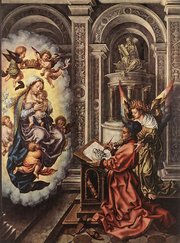Luke the Evangelist
|
|

Luke the Evangelist (Greek Λουκας Loukas) is said by tradition to be the author of both the Gospel of Luke and the Acts of the Apostles, the third and fifth books of the New Testament. He is patron saint of painters, physicians and healers, and his feast day is October 18.
His earliest notice is in Paul's Epistle to Philemon, verse 24. He is also mentioned in Colossians 4:14 and 2 Timothy 4:11, two works commonly ascribed to Paul. Our next earliest account of Luke is in the Anti-Marcionite Prologue to the Gospel of Luke, a document once thought to date to the 2nd century AD, but more recently has been dated to the later 4th century. However Helmut Koester claims the following part – the only part preserved in the original Greek – may have been composed in the late 2nd century:
- Luke is a Syrian of Antioch, a Syrian by race, a physician by profession. He had become a disciple of the apostles and later followed Paul until his [Paul's] martyrdom. Having served the Lord continuously, unmarried and without children, filled with the Holy Spirit he died at the age of 84 years. (p.335)
Some manuscripts add that Luke died "in Thebes, the capital of Boeotia". All of these facts support the conclusion that Luke was associated with Paul.
Later tradition elaborates on these few facts. Epiphanius states that Luke was one of the Seventy (Panerion 51.11), and John Chrysostom indicates at one point that the "brother" Paul mentions in 2 Corinthians 8:18 is either Luke or Barnabas. J. Wenham asserts that Luke was "one of the Seventy, the Emmaus disciple, Lucius of Cyrene and Paul's kinsman." Not all scholars are as confident of all of these attributes as Wenham is.
Another Christian tradition states that he was the first iconographer, and painted pictures of the Virgin Mary and of Peter and Paul. Thus late medieval guilds of St Luke in the cities of Flanders, or the Accademia di San Luca ("Academy of St Luke") in Rome, imitated in many other European cities during the 16th century, gathered together and protected painters.
Luke and the New Testament Books
Contemporary scholarship is far more skeptical about Luke's authorship of the Gospel attributed to him, and Acts. Neither work contains the name of its author, although several passages written in the first person plural (known as the We Sections), have traditionally been understood as the eye witness accounts of Luke. Both are also dedicated to one Theophilus, and Acts is clearly meant to be read as a sequel to the Gospel account; no scholar seriously doubts that the same person wrote both works.
On the other hand, the earliest manuscript of the Gospel (Papyrus Bodmer XIV = P75), dated circa AD 200, ascribes this work to Luke. Scholars defending Luke's authorship point out that there is no reason for these works to be attributed to such a minor figure if he did not write them, nor is there a tradition attributing this work to another author.
References
- Helmut Koester. Ancient Christian Gospels. Harrisburg, Pennsylvania: Trinity Press International, 1990.
- Burton L. Mack. Who Wrote the New Testament?: The Making of the Christian Myth. San Francisco, California: HarperCollins, 1996.
- J. Wenham, "The Identification of Luke", Evangelical Quarterly 63 (1991), 3-44
External link
- Early Christian Writings: (http://www.earlychristianwritings.com/luke.html) Gospel of Luke e-texts, introductionsde:Lukas (Evangelist)
es:Lucas el Evangelista fr:Luc (évangéliste) pt:Lucas sv:Lukas tl:San Lukas zh:路加
